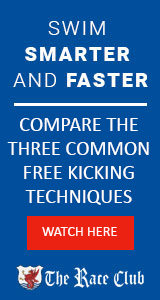Courtesy of Gary Hall Sr., 10-time World Record Holder, 3-time Olympian, 1976 Olympic Games US Flagbearer and The Race Club co-founder.
At The Race Club, we look at the freestyle kicking speed as the baseline speed for your freestyle. In other words, your all-out kicking speed for 50 yards is your baseline freestyle speed for 50 yards, before you add in your pulling and coupling motions. It is true that the shorter the race, the greater the contribution the kick makes to the overall freestyle speed. Therefore, the more important the kick becomes. However, the kick is meaningful for most fast swimmers, no matter what the distance and particularly when you want to put your freestyle into high gear at the finish.
Several years ago, I was coaching a 34 year old sprinter from Northern Ireland, Andy Hunter, who was trying to qualify for the Commonwealth Games. His goal was to reach 23.0 for the 50 meter LC freestyle. His PB was 24.6 and I had 6 months to try to help him reach his goal. That is like trying to drop a minute off of one’s 1500 time. But I was committed to try and so was he.
 He arrived from Ireland overweight, out of shape and with a 50 meter kicking time of 50 seconds. I told him he wouldn’t reach his goal of 23.0 unless he could kick 50 meters in 35 seconds or faster.
He arrived from Ireland overweight, out of shape and with a 50 meter kicking time of 50 seconds. I told him he wouldn’t reach his goal of 23.0 unless he could kick 50 meters in 35 seconds or faster.
In one of the first test meets in Ft. Lauderdale after he had arrived, Andy swam the 50 free LC with Cesar Cielo in the same heat. Cesar swam a 22.0 and Andy finished about 7 meters behind him in 25.2. Andy left the pool feeling very dejected. He felt even more so after I showed him the video of the race with him around 7 meters from the wall when Cesar finished.
“How in world can he beat me by 7 meters in a 50 meter race,” he asked? “How can that happen?”
I explained it to him this way. By the time he raced in Ft Lauderdale, Andy’s kick time had dropped to 45 seconds, which is 1.1 meters per second. Cesar could kick the same distance in around 30 seconds, which is 1.67 meters per second. After adding in the pulling and coupling motions (stroke rate of 120), Cesar boosted his swimming speed to just under 2.3 meters per second in order to swim 22.0. Andy boosted his swimming speed with a 140 stroke rate to 1.98 meters per second to swim the same race in 25.2 seconds. In other words, Cesar added .6 meters per second to his baseline speed while Andy added nearly .9 meters per second to his baseline speed.
Good for Andy! Unfortunately, because his baseline speed was so low, he was still over .3 meters per second slower in overall speed than Cesar. So I asked Andy, how long was Cesar swimming?
“22 seconds,” he responded.
“And what is 22 x .3”, I asked?
“6.6 meters”…..which is precisely where Andy was away from the wall when Cesar finished.
After 5 months of training and lots of ankle stretching and hard kicking sets, Andy improved his kicking time for 50 meters to 38 seconds. In his shaved, tapered meet he swam a 23.2 for the 50 freestyle, just off of his goal time and narrowly missing making the Commonwealth Games. In spite of that, I was pretty proud of him and that bit of coaching.
The bottom line is if you want to swim faster, whether it is a 50 sprint or finishing a 1500 meter race with after burners on, work on your kicking speed. To do so requires extraordinary plantar ankle flexibility, tremendous leg strength, proper kicking mechanics, and lots of kicking work.
Part of the proper biomechanics of freestyle kicking entails how much to bend your knees. This week, in Lanes 3 and 4, you will find an interesting webisode that compares three techniques of normal, overbending, and underbending the knees in freestyle kicking. This is using Velocity Meter technology with a 13 year old age group swimmer. We hope you enjoy!
Yours in Kicking,
Gary Sr.

Gary Hall, Sr., Technical Director and Head Coach of The Race Club (courtesy of TRC)
Like The Race Club on Facebook
Follow The Race Club on Instagram
Follow The Race Club on Twitter
Connect to The Race Club / Gary Hall Sr. on Linkedin
THE RACE CLUB
Because Life is Worth Swimming, our mission is to promote swimming through sport, lifelong enjoyment, and good health benefits. Our objective is for each member of and each participant in The Race Club to improve his or her swimming performances, health, and self-esteem through our educational programs, services and creativity. We strive to help each member of The Race Club overcome challenges and reach his or her individual life goals.
The Race Club provides facilities, coaching, training, technical instruction, video, fitness and health programs for swimmers of all ages and abilities. Race Club swim camps are designed and tailored to satisfy each swimmer’s needs, whether one is trying to reach the Olympic Games or simply improve one’s fitness. Our programs are suitable for beginner swimmers, pleasure swimmers, fitness swimmers, USA swimming or YMCA swimmers, or triathletes; anyone who wants to improve swimming skills. All of our Race Club members share an enjoyment of being in the water and use swimming to stimulate a more active mind and body.

